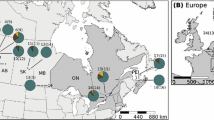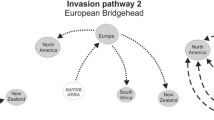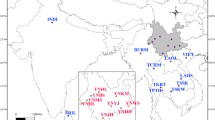Abstract
Cydia pomonella (L.) was firstly reported in China in the 1950s and considered as one of the most serious invasive pest in fruit orchards of China. It spread rapidly from the original site in **njiang to other northwestern regions. The pest has further penetrated northeastern China since 2006. With its rapid invasion rate, most pome fruit production areas of China are being threatened. As yet there has been no research into the genetic diversity and structure of the codling moth population in China. We investigated the genetic variations of 12 C. pomonella populations collected from the main distribution regions (**njiang, Gansu and Heilongjiang Provinces) in China and compared them with one German and one Swiss population using eight microsatellites loci to infer the characteristics of genetic diversity and genetic structure. We observed sequential loss of genetic diversity and significant structuring associated with distribution but no significant correlation between genetic distance and geographic distance among northwestern populations. There was no genetic evidence for bottleneck effects in any of the populations. The results suggest that the loss of genetic diversity in C. pomonella populations resulted from the successive colonization of founder populations. Recent invasion history led to the lack of any bottleneck effect. The high level of population genetic structuring is related to the weak flight capacity of the codling moth and the human-aided dispersal rather than to geographic distance. These genetic data not only provide us with an understanding of the micro-evolutionary processes related to successful biological invasions, but also provide guidance for pest management strategies.



Similar content being viewed by others
References
Ahern RG, Hawthorne DJ, Raupp MJ (2009) Founder effects and phenotypic variation in Adelges cooleyi, an insect pest introduced to the eastern United States. Biol Invasions 11:959–971
Ayres RM, Pettigrove VJ, Hoffmann AA (2010) Low diversity and high levels of population genetic structuring in introduced eastern mosquitofish (Gambusia holbrooki) in the greater Melbourne area, Australia. Biol Invasions 12:3727–3744
Barnes MM (1991) Codling moth occurrence, host race formation and damage. In: Van der Guest LPS, Evenhuis HH (eds) Tortricid pests: their biology, natural enemies and control. Elsevier, Amsterdam, pp 313–328
Bohonak AJ (1999) Dispersal, gene flow and population structure. Q Rev of Biol 74:21–45
Boivin T, Bouvier J-C, Beslay D, Sauphanor B (2004) Variability in diapause propensity within populations of a temperate insect species: interactions between insecticide resistance genes and photoperiodism. Biol J Linn Soc 83:341–351
Bonnet E, Van der Peer Y (2002) ZT: a software tool for simple and partial Mantel tests. J Stat Software 7:1–12
Bouvier J-C, Buès R, Boivin T, Boudinhon L, Beslay D, Sauphanor B (2001) Deltamethrin resistance in the codling moth (Lepidoptera: Tortricidae): inheritance and number of genes involved. Heredity 82:456–462
Brown JE, Stepien CA (2009) Invasion genetics of the Eurasian round goby in North America: tracing source and spread patterns. Mol Eco 18:64–79
Cardé RT, Minks AK (1995) Control of moth pests by mating disruption: successes and constraints. Ann Rev Entomol 40:559–585
Cham S (2002) Range expansion of the small red-eyed damselfly Erythromma viridulum (Charp.) in the British Isles. Atropos 15:3–9
Chen MH, Dorn S (2009) Microsatellites reveal genetic differentiation among populations in an insect species with high genetic variability in dispersal, the codling moth, Cydia pomonella (L.) (Lepidoptera: Tortricidae). Bull Entomol Res 100:75–85
Ciosi M, Miller NJ, Kim KS, Giordano R, Estoup A, Guillemaud T (2008) Invasion of Europe by the western corn rootworm, Diabrotica virgifera virgifera: multiple transatlantic introductions with various reductions of genetic diversity. Mol Ecol 17:3614–3627
Cornuet JM, Luikart G (1996) Description and power analysis of two tests for detecting recent population bottlenecks from allele frequency data. Genetics 144:2001–2014
Cristescu R, Sherwin WB, Handasyde K, Cahill V, Cooper DW (2010) Detecting bottlenecks using BOTTLENECK 1.2.02 in wild populations: the importance of the microsatellite structure. Conserv Genet 11:1043–1049
Dakin EE, Avise JC (2004) Microsatellite null alleles in parentage analysis. Heredity 93:504–509
De Barro PJ (2005) Genetic structure of the whitefly Bemisia tabaci in the Asia-Pacific region revealed using microsatellite markers. Mol Ecol 14:3695–3718
Di Rienzo A, Peterson AC, Garza JC, Valdes AM, Slatkin M, Freimer NB (1994) Mutational processes of simple-sequence repeat loci in human populations. Proc Nati Acad Sci USA 91:3166–3170
Dieringer D, Schlötterer C (2003) MICROSATELLITE ANALYSER (MSA): a platform independent analysis tool for large microsatellite data sets. Mol Ecol Notes 3:167–169
Dlugosch KM, Parker IM (2008) Founding events in species invasions: genetic variation, adaptive evolution, and the role of multiple introductions. Mol Ecol 17:431–449
Dorn S, Schumacher P, Abivardi C, Meyhöfer R (1999) Global and regional pest insects and their antagonists in orchards: spatial dynamics. Agric Ecosyst Environ 73:111–118
Espinoza JL, Fuentes-Contreras E, Barros W, Ramírez C (2007) Utilización de microsatélites para la determinación de la variabilidad genética de la polilla de la manzana Cydia pomonella L. (Lepidoptera: Tortricidae) en Chile Central. Agric Téc (Chile) 67:244–252
Evanno G, Regnaut S, Goudet J (2005) Detecting the number of clusters of individuals using the software STRUCTURE: a simulation study. Mol Ecol 14:2611–2620
Excoffier L, Laval G, Schneider S (2005) Arlequin ver. 3.0: an integrated software package for population genetics data analysis. Evol Bioinform Online 1:47–50
Franck P, Timm AE (2010) Population genetic structure of Cydia pomonella: a review and case study comparing spatiotemporal variation. J Appl Entomol 134:191–200
Franck P, Guérin F, Loiseau A, Sauphanor B (2005) Isolation and characterization of microsatellite loci in the codling moth Cydia pomonella L. (Lepidoptera, Tortricidae). Mol Ecol Notes 5:99–102
Franck P, Reyes M, Olivares J, Sauphanor B (2007) Genetic architecture in codling moth populations: comparison between microsatellite and insecticide resistance markers. Mol Ecol 16:3554–3564
Fuentes-Contreras E, Espinoza JL, Lavandero B, Ramírez CC (2008) Population genetic structure of codling moth (Lepidoptera: Tortricidae) from apple orchards in central Chile. J Econ Entomol 101:190–198
Ghabooli S, Shiganova TA, Zhan AB, Cristescu ME, Eghtesadi-Araghi P, MacIsaac HJ (2011) Multiple introductions and invasion pathways for the invasive ctenophore Mnemiopsis leidyi in Eurasia. Biol Invasions 13:679–690
Gillis NK, Walters LJ, Fernandes FC, Hoffman EA (2009) Higher genetic diversity in introduced than in native populations of the mussel Mytella charruana: evidence of population admixture at introduction sites. Divers Distrib 15:784–795
Grapputo A, Boman S, Lindstrom L, Lyytinen A, Mappes J (2005) The voyage of an invasive species across continents: genetic diversity of North American and European Colorado potato beetle populations. Mol Ecol 14:4207–4219
Herborg L-M, Weetman D, van Oosterhout C, Hanfling B (2007) Genetic population structure and contemporary dispersal patterns of a recent invader, the Chinese mitten crab, Eriocheir sinensis. Mol Ecol 16:231–242
Higbee BS, Calkins CO, Temple CA (2001) Overwintering of codling moth (Lepidoptera: Tortricidae) larvae in apple harvest bins and subsequent moth emergence. J Econ Entomol 94:1511–1517
Hufbauer RA, Bogdanowicz SM, Harrison RG (2004) The population genetics of a biological control introduction: mitochondrial DNA and microsatellite variation in native and introduced populations of Aphidus ervis, a parasitoid wasp. Mol Ecol 13:337–348
Lee CE (2002) Evolutionary genetics of invasive species. Trends Ecol Evol 17:386–391
Luikart G, Sherwin WB, Steele BM, Allendorf FW (1998) Usefulness of molecular markers for detecting population bottlenecks via monitoring genetic change. Mol Ecol 7:963–974
Mani E, Wildbolz T (1977) The dispersal of male codling moths (Laspeyresia pomonella L.) in the Upper Rhine Valley. J Appl Entomol 47:39–48
Mantel N (1967) The detection of disease clustering and a generalized regression approach. Canc Res 27:209–220
Margaritopoulos JT, Kasprowicz L, Malloch GL, Fenton B (2009) Tracking the global dispersal of a cosmopolitan insect pest, the peach potato aphid. BMC Ecol 9:13
Meglécz E, Petenian F, Danchin E, Coeur D’Acier A, Rasplus J-Y, Faure E (2004) High similarity between flanking regions of different microsatellites detected within each of two species of Lepidoptera: Parnassius apollo and Euphydryas aurinia. Mol Ecol 13:1693–1700
Meng XF, Shi M, Chen XX (2008) Population genetic structure of Chilo suppressalis (Walker) (Lepidoptera: Crambidae): strong subdivision in China inferred from microsatellite markers and mtDNA gene sequences. Mol Ecol 17:2880–2897
Meraner A, Brandstätter A, Thaler R, Aray B, Unterlechner M, Niederstätter H, Parson W, Zelger R, Dalla Via J, Dallinger R (2008) Molecular phylogeny and population structure of the codling moth (Cydia pomonella) in Central Europe: I. Ancient clade splitting revealed by mitochondrial haplotype markers. Mol Phylogenet Evol 48:825–837
Miller NJ, Birley AJ, Overall ADJ, Tatchell GM (2003) Population genetic structure of the lettuce root aphid, Pemphigus bursarius (L.), in relation to geographic distance, gene flow and host plant usage. Heredity 91:217–223
Mozaffarian F, Mardi M, Sarafrazi A, Ganbalani N (2007) Assessment of geographic and host-associated population variations of the carob moth, Ectomyelois ceratoniae, on pomegranate, fig, pistachio and walnut, using AFLP markers. J Insect Sci 8:6
Myers CT, Hull LA, Krawczyk G (2006) Comparative survival rates of oriental fruit moth (Lepidoptera: Tortricidae) larvae on shoots and fruit of apple and peach. J Econ Entomol 99:1299–1309
Nei M, Maruyama T, Chakraborty R (1975) The bottleneck effect and genetic variability in populations. Evolution 29:1–10
Novak SJ, Mack RN (1993) Genetic variation in Bromus tectorum (Poaceae): comparison between native and introduced populations. Heredity 71:167–176
Orsini L, Corander J, Alasentie A, Hanski I (2008) Genetic spatial structure in a butterfly metapopulation correlates better with past than present demographic structure. Mol Ecol 17:2629–2642
Parr AJ (2005) Migrant and dispersive dragonflies in Britain during 2004. J Br Dragonfly Soc 21:14–20
Paupy C, Chantha N, Reynes J-M, Failloux A-B (2005) Factors influencing the population structure of Aedes aegypti from the main cities in Cambodia. Heredity 95:144–147
Piry S, Luikart G, Cornuet JM (1999) BOTTLENECK: a computer program for detecting recent reductions in effective population size from allele frequency data. J Hered 90:502–503
Primmer CR, Saino N, Møller AP, Ellegren H (1998) Unraveling the processes of microsatellite evolution through analysis of germ line mutations in barn swallows, Hirundo rustica. Mol Biol Evol 15:1047–1054
Pritchard JK, Stephens M, Donnelly P (2000) Inference of population structure using multilocus genotype data. Genetics 155:945–959
Pruett CI, Winker K (2005) Northwestern song sparrow populations show genetic effects of sequential colonization. Mol Ecol 14:1421–1434
Ramachandran S, Deshpande O, Roseman CC, Rosenberg NA, Feldman MW, Cavalli-Sforza LL (2005) Support from the relationship of genetic and geographic distance in human populations for a serial founder effect originating in Africa. Proc Natl Acad Sci USA 102:15942–15947
Ramstad KM, Woody CA, Sage GK, Allendorf FW (2004) Founding events influence genetic population structure of sockeye salmon (Oncorhynchus nerka) in Lake Clark, Alaska. Mol Ecol 13:277–290
Rice WR (1989) Analyzing tables of statistical tests. Evolution 43:223–225
Roff DA (1994) The evolution of flightlessness: is history important? Evol Ecol 8:639–657
Roman J, Darling JA (2007) Paradox lost: genetic diversity and success of aquatic invasions. Trends Ecol Evol 22:454–464
Rosenberg NA (2004) DISTRUCT: a program for the graphical display of population structure. Ecol Evol Notes 4:137–138
Rousset F (2008) GENEPOP’007: a complete re-implementation of the GENEPOP software for Windows and Linux. Mol Ecol Resour 8:103–106
Schuelke M (2000) An economic method for the fluorescent labeling of PCR fragments. Nat Biotechnol 18:233–234
Shel‘Deshova GG (1967) Ecological factors determining distribution of the codling moth Laspeyresia pomonella (Lepidoptera: Tortricidae) in the northern and southern hemispheres. Entomol Rev 46:349–361
Slatkin M (1993) Isolation by distance in equilibrium and non-equilibrium populations. Evolution 47:264–279
Szpiech ZA, Jakobsson M, Rosenberg NA (2008) ADZE: a rarefaction approach for counting alleles private to combinations of populations. Bioinformatics 24:2498–2504
Timm AE, Geertsema H, Warnich L (2006) Gene flow among Cydia pomonella (Lepidoptera: Tortricidae) geographic and host populations in South Africa. J Econ Entomol 99:341–348
Torriani MVG, Mazzi D, Hein S, Dorn S (2010) Structured populations of the oriental fruit moth in an agricultural ecosystem. Mol Ecol 19:2651–2660
Van Oosterhout C, Hutchinson WF, Wills DPM, Shipley P (2004) MICRO-CHECKER: software for identifying and correcting genoty** errors in microsatellite data. Mol Ecol Notes 4:535–538
Wan FH, Guo JY, Zhang F (2009) Research on biological invasions in China. Science Press, Bei**g
Watts PC, Keat S, Thompson DJ (2010) Patterns of spatial genetic structure and diversity at the onset of a rapid range expansion: colonization of the UK by the small red-eyed damselfly Erythromma viridulum. Biol Invasions 12:3887–3903
Weir BS, Cockerham CC (1984) Estimating F-statistics for the analysis of population-structure. Evolution 38:1358–1370
Willett MJ, Neven L, Miller CE (2009) The occurrence of codling moth in low latitude countries: validation of pest distribution reports. Hort Technology 19:633–637
Wright S (1951) The genetical structure of populations. Ann Eugen 15:323–354
Wright S (1978) Evolution and genetics of populations. University of Chicago, Chicago
Zhang XZ (1957) Taxonomic notes on the codling moth, Carpocapsa pomonella L. in Sinkiang. Acta Entomol Sin 7:467–472
Acknowledgments
We thank Dr. John Richard Schrock, Emporia State University, Emporia, KS, USA, for language correction of the draft. We are grateful to Anyong Wang, Kun Dong, Chunhan Zheng, Jianqiang Yang, **ao Zhao and **nglong Huang for their help in the collection of codling moth samples. This work was supported by grants from the ‘13115’ Sci-Tech Innovation Project of Shaanxi Province (No. 2009ZDKG-06), the Special Fund for Agro-scientific Research in the Public Interest (No. 200903042-03), the National Natural Science Foundation of China (No. 31071687), the International Atomic Energy Agency (No. 16341) and the Talent Recruitment Project of Northwest A & F University.
Author information
Authors and Affiliations
Corresponding author
Appendix
Appendix
See Table 4.
Rights and permissions
About this article
Cite this article
Men, QL., Chen, MH., Zhang, YL. et al. Genetic structure and diversity of a newly invasive species, the codling moth, Cydia pomonella (L.) (Lepidoptera: Tortricidae) in China. Biol Invasions 15, 447–458 (2013). https://doi.org/10.1007/s10530-012-0299-5
Received:
Accepted:
Published:
Issue Date:
DOI: https://doi.org/10.1007/s10530-012-0299-5




